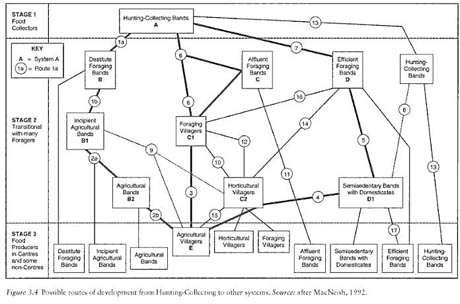
IMAGE: “Possible routes of development from Hunting-Collecting to other systems,” from Deforesting The Earth: From Prehistory to Global Crisis by Michael Williams, via Social Fiction. Click here for larger size.
An important factor in the domestication process was defecation. The seeds of sweet-corn, tomatoes, lemons, cucumbers, and many more edible plants, as well as fruits of shrubs and trees, can pass intact through the human as well as the animal gut (it may even enhance their reproductive vigour), and can be subsequently dispersed and reproduced. In the case of humans the peripheral latrine areas common to virtually all societies would become new gardens in time.
The image and quote above both come from Deforesting The Earth: From Prehistory to Global Crisis by Michael Williams and were posted by Wilfried Houjebek on his blog, Social Fiction.
Archaeobotanists and paleoethnologists have long regarded human waste deposits as the richest cache of information to be found in ancient settlements. Ancestral excrement provides an archive of long-last intangibles, from environmental conditions and botanical evolution to early human dietary habits and lifestyles.
Interestingly, though, Michael Williams’ last sentence describes a geography of domestication, as latrine sites became, in Jared Diamond’s words, “a testing ground for the first crop breeders.” Peripheral but convenient, early toilets formed an unintentional architecture of collection and cultivation, perfectly designed to capture and spatially concentrate our preferred seeds (those of the fruits, legumes, and grains that humans sought out and ate in quantity). Human manure thus nourished pockets of edible crops on the edge of human settlements: proto-fields based on the landscape of waste management.

